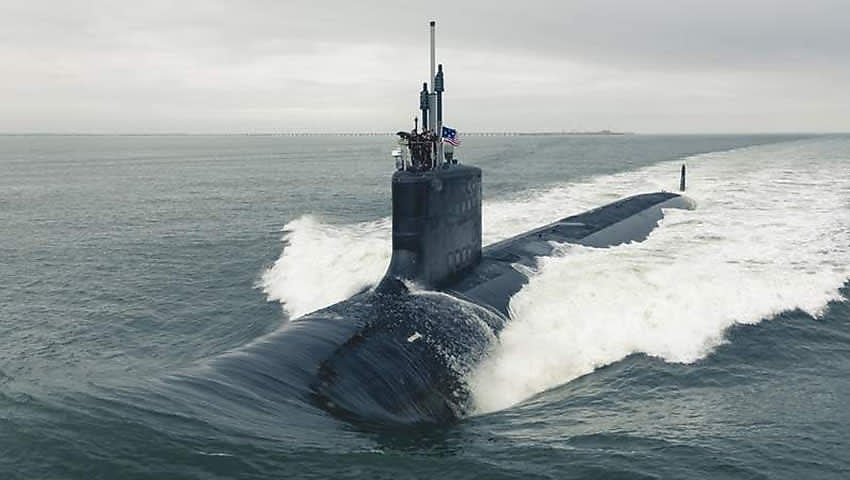Opinion: Media and political commentators invariably focus on the all-up acquisition cost of major defence programs and sometimes even add the life cycle sustainment cost to produce a gigantic total figure intended to capture attention. This mostly succeeds but does not produce the antipathy the commentator had hoped, writes former naval officer and analyst Christopher Skinner.
To continue reading the rest of this article, please log in.
Create free account to get unlimited news articles and more!
Most people realise that such sensationalism does not identify the major challenge, which is acquiring capability that can be used when it is needed. And that may be constrained by any number of lacking resources — timeline, infrastructure, human resources both in numbers but even more so, possessing the necessary qualifications and skills, or raw materials, components, sub-assemblies or the essential information and intellectual property rights.
The imminent public announcement of the AUKUS nuclear submarine strategy and more comprehensively the public release of the Defence Strategic Review report have led to a plethora of media articles endlessly rehashing the options for various large defence programs. In every case, the emphasis is on the very large dollar estimate for the total scale of the program in question, with only cursory mention of the extended timescale over which the program would be delivered.
The result is hesitancy to make essential investments leading inevitably to delayed or even cancelled program deliveries.
Governments and their professional services and bureaucrats know better than to allow such sensationalism to affect their deliberations but generally fail to explain why. There is a simple but compelling explanation that is all about the timing of funding required for very large programs that are fulfilled over decades and only require funding incrementally over that period. The resulting funding in each year or budget cycle is acceptable and also can be adjusted as the program progresses.
Take the AUKUS nuclear submarine program for example, and the following nominal parameters:
- Eight nuclear-powered attack submarines (SSN)
- Each SSN to cost say AU$10 billion => $80 billion total direct cost of acquisition with spending evenly spread over the building period of 10 years
- Up-front non-recurring investment cost of, say, $30billion over the period from 2023 until 2034
- Each SSN to require 10 years from start to delivery, with first boat to start in 2028, the second SSN after three years and then at two-year intervals for the remainder.
This then looks like the following:
|
20- |
23 |
24 |
25 |
26 |
27 |
28 |
29 |
30 |
31 |
32 |
33 |
34 |
35 |
36 |
37 |
38 |
Deliver |
|
Total |
1 |
3 |
3 |
4 |
4 |
4 |
4 |
4 |
4 |
4 |
4 |
4 |
4 |
4 |
5 |
5 |
|
|
Invest |
1 |
3 |
3 |
4 |
4 |
3 |
3 |
3 |
2 |
2 |
1 |
1 |
|||||
|
SSN-1 |
1 |
1 |
1 |
1 |
1 |
1 |
1 |
1 |
1 |
1 |
2037 |
||||||
|
SSN-2 |
1 |
1 |
1 |
1 |
1 |
1 |
1 |
1 |
2040 |
||||||||
|
SSN-3 |
1 |
1 |
1 |
1 |
1 |
1 |
2042 |
||||||||||
|
SSN-4 |
1 |
1 |
1 |
1 |
2044 |
||||||||||||
|
SSN-5 |
1 |
1 |
2046 |
||||||||||||||
|
SSN-6 to 8 at two-year intervals, delivering in 2048, 2050, 2052. Annual investment funding of $5B |
|||||||||||||||||
The conclusion from this projected spend profile is a steady requirement for not more than $4 billion each year for the first 12 years and slightly more thereafter depending on the delivery intervals and sustainment costs of delivered boats. Importantly the number of delivered boats totals two by 2040 and all eight by 2052.
For the overall Defence Strategic Review, the same principle applies but with a diverse portfolio of programs — some immediate, others much longer term. The review arose from the profound realisation that the previous comfortable assumption of 10-years’ warning time no longer applied and therefore strategic planning must examine all possible constraints applicable to acquisition of each portfolio program, and no longer accept that financial resources were the sole constraint.
There may well be significant lead-times to develop infrastructure, or investment needed in human resources to develop and operate defence materiel. A frequently encountered constraint is the availability of a qualified, skilled workforce and that cannot be solved purely by immigration. There must be greater numbers of students graduating with scientific, technological, and engineering qualifications and then attracting them to work on defence programs. This has been recognised as a more urgent need following the interruption of overseas supply chains in some critical fields.
The inescapable conclusion from the uncertainty now experienced in national security is that we need to identify what complex defence material we need to acquire and then work out very decisively what needs to be done to achieve these goals and what resource constraints apply. The Defence Strategic Review will have done much of this work. The government will now have the task of working out how to generate the necessary resources.

 Login
Login







